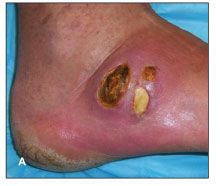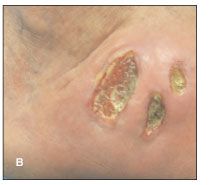- Clinical Technology
- Adult Immunization
- Hepatology
- Pediatric Immunization
- Screening
- Psychiatry
- Allergy
- Women's Health
- Cardiology
- Pediatrics
- Dermatology
- Endocrinology
- Pain Management
- Gastroenterology
- Infectious Disease
- Obesity Medicine
- Rheumatology
- Nephrology
- Neurology
- Pulmonology
Mycobacterium avium-intracellulare Complex Immune Reconstitution Inflammatory Syndrome in HIV/AIDS Presenting as Osteomyelitis
We report a case of osteomyelitis due to Mycobacterium avium-intracellulare complex (MAC) in an AIDS patient shortly after the initiation of antiretroviral therapy with subsequent immune reconstitution inflammatory syndrome (IRIS).
Mycobacterium avium-intracellulare complex (MAC) is an atypical mycobacterium known to cause various infections, including osteomyelitis, in persons with HIV/AIDS. At CD4+ cell counts below 50/µL, MAC infections are common and are associated with significant morbidity and mortality, leading to the recommendation for universal prophylaxis with macrolides or rifabutin. MAC has also been implicated in immune reconstitution inflammatory syndrome (IRIS) in patients treated with effective antiretroviral therapy. Pulmonary involvement, lymphadenitis, and exacerbation of disseminated disease have all been well described in the literature. While osteomyelitis caused by MAC has been described, there are few published reports of MAC osteomyelitis occurring soon after initiation of antiretroviral therapy. We report a case of MAC osteomyelitis occurring 3 months after initiation of antiretroviral therapy.
CASE SUMMARY
A 58-year-old man with AIDS and extensive antiretroviral experience presented to his local clinic to start a new antiretroviral regimen. His absolute CD4+ cell count was 15/µL, and his HIV RNA level (using HIV branched DNA quantitative assay) was 26,555 copies/mL. He reported feeling well without any physical complaints. He also reported adherence to azithromycin prophylaxis, and he was taking oral prednisone for rheumatoid arthritis.
The patient was started on a new antiretroviral regimen of emtricitabine/tenofovir fixed-dose combination, ritonavir-boosted darunavir, and enfuvirtide. Ten weeks later, his absolute CD4+ cell count had risen to 47/µL and his HIV RNA level had fallen to undetectable levels (less than 75 copies/mL). One month later, he began having progressively worsening pain, swelling, and redness in his right ankle with subjective fevers and chills. These symptoms persisted for 2 months; he then visited a health care provider.
Physical examination revealed a 4 x 4-cm ulcer surrounded by erythema over the lateral aspect of the ankle (Figure, A). A sterile metal probe was inserted into the ulcer and reached bone in 3 separate locations. MRI of the leg revealed changes consistent with osteomyelitis in the anterior calcaneus and cuboid bones of the right foot.
The patient was admitted to the hospital for further evaluation and treatment for osteomyelitis. An orthopedic evaluation led to surgical debridement of the ulcerated soft tissue lesion. In addition, a cuboid bone biopsy was performed by the interventional radiology service. Examination of the bone biopsy specimen revealed acute and chronic inflammation and granulation tissue consistent with osteomyelitis. Both the debrided tissue and the bone biopsy tissue grew MAC. A blood culture was negative for mycobacteria after 6 weeks.
A regimen of clarithromycin, ethambutol, and rifabutin was started, and there was gradual improvement in the patient’s symptoms and in the appearance of the lesion. Antiretroviral therapy was continued throughout this time. At a 4-month follow-up visit, the lesion was healing and the patient was asymptomatic (Figure, B).


Figure. A: The lesion of the 58-year-old HIV-infected case patient at the time of diagnosis of osteomyelitis, before debridement. B: The same lesion at follow-up after 4 months of therapy. Note the reduced erythema and swelling, as well as slow healing of the ulcerated lesions.DISCUSSION
IRIS was initially described in the 1990s in patients with HIV/AIDS who were receiving antiretroviral therapy. Although the process of immune reconstitution in HIV/AIDS is not fully understood, there are many data suggesting that antiretroviral therapy can lead to an improved functional immune response over time. IRIS-related infections have recently become more prominent, with one study suggesting that IRIS develops in as many as 31.6% of HIV-infected patients while they are receiving antiretroviral therapy, often within the first 60 days after therapy is initiated.1
Clinically, in patients who carry a diagnosis of AIDS, IRIS has been defined loosely as a rise in the absolute CD4+ cell count accompanied by a drop in the HIV-1 RNA level after initiation of antiretroviral therapy, with subsequent development of an inflammatory or infectious condition that cannot be explained as a newly acquired infection or expected clinical course of a previous infection.2,3 This definition has recently been further narrowed to include more specific criteria.4 In particular, our patient met these criteria by having had a decrease in his HIV RNA level of 1 log10 copies/mL or greater with an increase in the absolute CD4+ cell count of 25/µL or more along with development of a biopsy-proven inflammatory infection shortly after having begun antiretroviral therapy. The bone biopsy specimen in this case demonstrated a local inflammatory response to MAC, which was cultured from the same location.
An English language literature review using MEDLINE from 1950 to 2008 revealed 11 cases of MAC osteomyelitis in patients with HIV/ AIDS who had responded to antiretroviral therapy (Table).5-11 In most of these patients, the disease developed more than 10 months after starting therapy. In only 1 reported case patient, MAC osteomyelitis developed 3 months after initiating a new antiretroviral regimen. He had been on a 2-drug regimen of zidovudine and lamivudine and had a CD4+ cell count of 8/µL and an HIV RNA level of 292,000 copies/mL, but once the protease inhibitor indinavir was added, his CD4+ cell count rose to 98/µL and his HIV RNA level dropped to 800 copies/mL within 3 months. As with our patient, this patient is reported to have had no systemic complaints and no evidence of disseminated disease. However, this case differed from ours in that the patient also had an overlying soft tissue abscess and septic arthritis in the knee joint.
Our patient did not have clinical or radiographic evidence of abscess formation. His infection was relatively uncomplicated and localized to the bone. He also had ulceration of the overlying soft tissue rather than abscess formation.
MAC osteomyelitis occurred in a variety of locations in the current case series, but the spine was most commonly involved. The infections also often involve surrounding abscess formation and soft tissue disease. Our case represents, to our knowledge, the best-described peripheral location of MAC osteomyelitis manifestation associated with IRIS. It is important to note that in all other reported cases, the patients were not receiving MAC infection prophylaxis at the time of onset of symptoms. All patients showed improvement after a prolonged course of therapy, with the exception of 1 patient who died of an unrelated infection shortly after the diagnosis of osteomyelitis.9
Anti-inflammatory agents, such as NSAIDs and corticosteroids, have been used to treat IRIS-related conditions, but clear guidelines on how to use these adjunctive agents have not been defined.12 Surgical debridement was necessary in fewer than half the cases, and anti-inflammatory therapy was used in only 1 case from the literature review.
As novel antiretroviral drugs continue to be produced and access to therapy improves, IRIS will continue to be a problematic phenomenon during antiretroviral treatment. Early recognition of disease states related to IRIS and appropriate treatment intervention can reduce morbidity and mortality in persons with HIV/AIDS.
Prophylaxis for opportunistic infections, including those caused by MAC, is important in limiting occurrence of these diseases. Because MAC is a common opportunistic pathogen in persons with HIV/AIDS, it should be considered during evaluation of IRIS-related clinical presentations such as osteomyelitis.
No potential conflict of interest relevant to this article was reported by the authors.
References:
References1. Shelburne SA, Visnegarwala F, Darcourt J, et al. Incidence and risk factors for immune reconstitution inflammatory syndrome during highly active antiretroviral therapy. AIDS. 2005;19:399-406.
2. Lawn SD, Bekker L, Miller RF. Immune reconstitution disease associated with mycobacterial infections in HIV-infected individuals receiving antiretrovirals. Lancet Infect Dis. 2005;5:361-373.
3. Shelburne SA, Hamill RJ, Rodriguez-Barradas MC, et al. Immune reconstitution inflammatory syndrome: emergence of a unique syndrome during highly active antiretroviral therapy. Medicine (Baltimore). 2002;81:213-227.
4. Robertson J, Meier M, Wall J, et al. Immune reconstitution syndrome in HIV: validating clinical predictors in persons initiating antiretroviral therapy. Clin Infect Dis. 2006;42:1639-1646.
5. Sheppard DC, Sullam PM. Primary septic arthritis and osteomyelitis due to Mycobacterium avium complex in a patient with AIDS. Clin Infect Dis. 1997;25:925-926.
6. Erard P, Robert-Granpierre F, Kaeser P. Vertebral osteomyelitis caused by Mycobacterium avium-intracellulare in a patient with AIDS. Clin Microbiol Infect. 1999;5:643-644.
7. Nalaboff KM, Rozenshtein A, Kaplan MH. Imaging of Mycobacterium avium-intracellulare infection in AIDS patients on highly active antiretroviral therapy: reversal syndrome. AJR. 2000;175:387-390.
8. Currier JS, Williams PL, Koletar SL, et al. Discontinuation of Mycobacterium avium complex prophylaxis in patients with antiretroviral therapy-induced increases in CD4+ cell count. A randomized, double-blind, placebo-controlled trial. AODS Clinical Trials Group 362 Study Team. Ann Intern Med. 2000;133: 493-503.
9. Aberg JA, Chin-Hong PV, McCutchan A, et al. Localized osteomyelitis due to Mycobacterium avium complex in patients with human immunodeficiency virus receiving highly active antiretroviral therapy. Clin Infect Dis. 2002;35:E8-E13.
10. Phillips P, Bonner S, Gataric N, et al. Nontuberculous mycobacterial immune reconstitution syndrome in HIV-infected patients: spectrum of disease and long-term follow-up. Clin Infect Dis. 2005;41:1483-1497.
11. Corrales-Medina V, Symes S, Valdivia-Arenas M, Boulanger C. Localized Mycobacterium avium complex infection of vertebral and paravertebral structures in an HIV patient on highly active antiretroviral therapy. South Med J. 2006;99:174-177.
12. Hirsch HH, Kaufmann G, Sendi P, Battegay M. Immune reconstitution in HIV-infected patients. Clin Infect Dis. 2004;38:1159-1166.
Â
